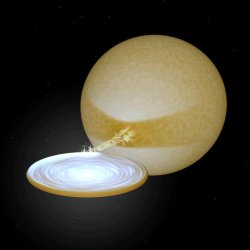deeplink to this page
UCXBs
We studied the formation of ultra-compact X-ray binaries (UCXBs). These stars are LMXBs with orbital periods less than about an hour. A relatively large fraction of observed UCXBs is observed in the densely populated globular clusters. There are two suggested scenarios to form these systems. Firstly, they could be formed through stable mass transfer, under the influence of strong angular-momentum loss, e.g. due to a process called magnetic braking. This will allow the system to decrease its orbital period while mass transfer is going on. In the second scenario, either a common-envelope phase in a binary with a giant and a neutron star, or envelope injection due to a direct stellar collision between a giant and a neutron star, would bring the core of the giant (a white dwarf) and the neutron star in a close orbit. This orbit will then decay due to the emission of gravitational radiation, until the orbital period is a few minutes, and the white dwarf will start mass transfer onto the neutron star, and an ultra-compact X-ray binary is formed.
Closely related to this is a project that concerns the formation of the (probably ultra-compact) X-ray binary 2S 0918-549. This binary is observed in the field (rather than in a globular cluster), and was therefore probably formed in a common envelope. For field-stars, a collision is practically impossible, because of the low stellar density, while the field population is much younger than that in globular clusters, so that stars massive enough for the common-envelope scenario to work are still present. Observations of 2S 0918-549 indicate a high abundance of neon, compared to that of oxygen. We show that the neon-to-oxygen ratio for this system is naturally explained when we assume that the donor star in the system is a helium white dwarf, and hence the common envelope happened on the red-giant branch (In `t Zand et al, 2005). The images on this page were made by the author, using Rob Hynes' visualisation program BinSim. |

